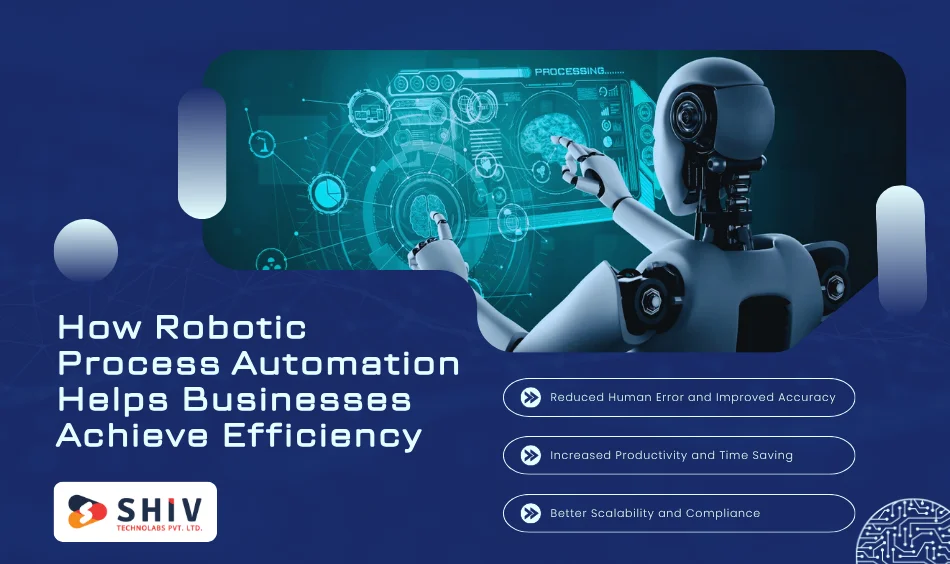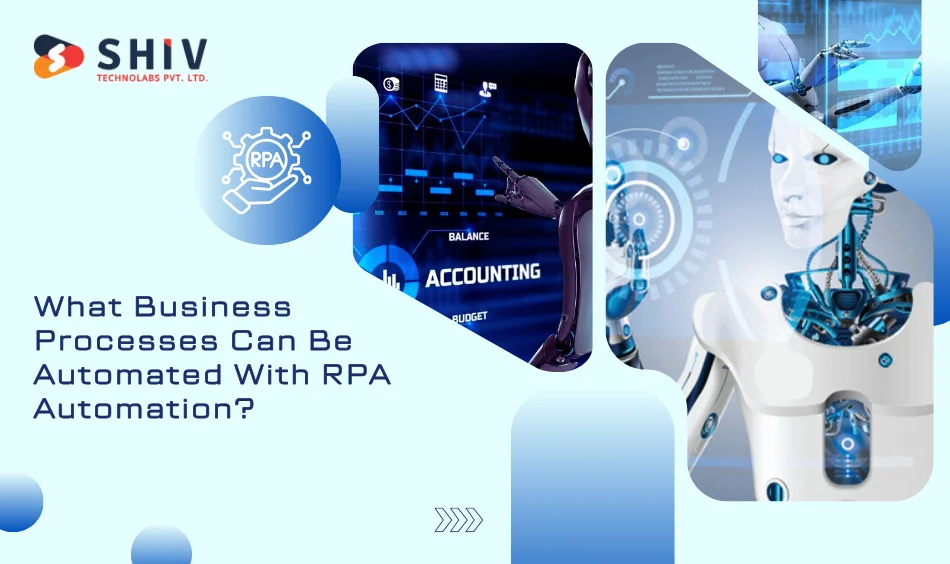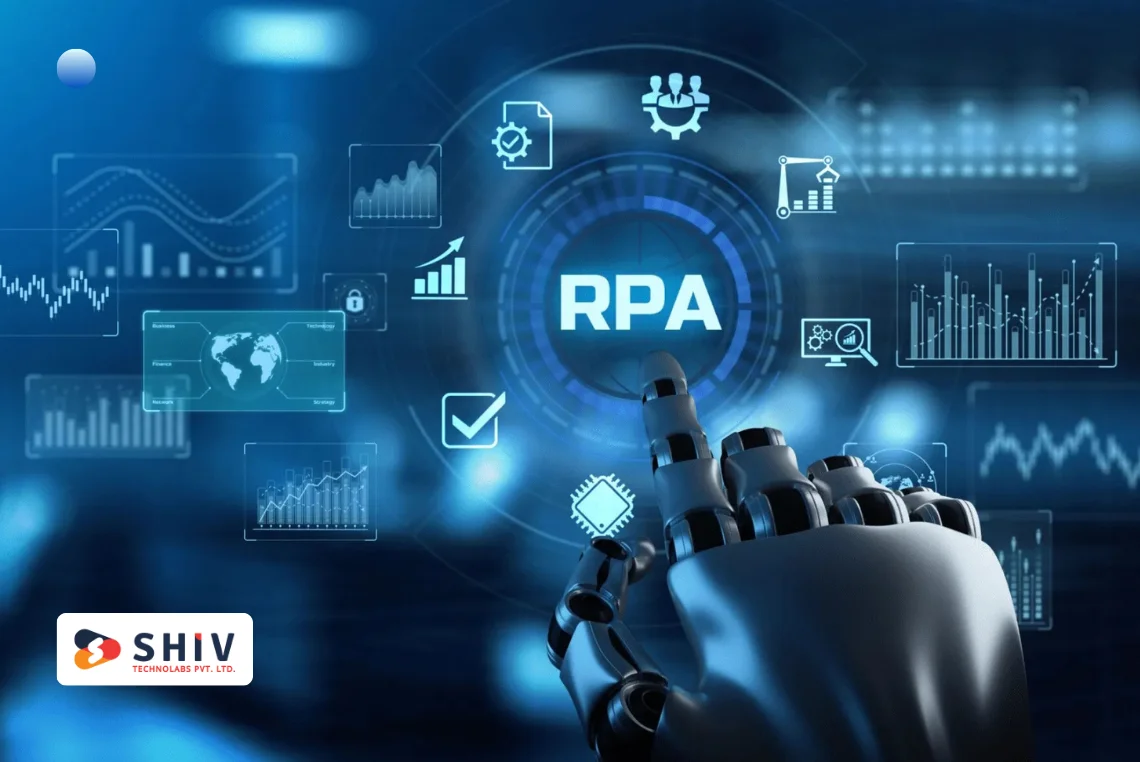Table of Contents
Development Services Robotic Process Automation (RPA) is transforming the way organisations undertake their repetitive, data-intensive processes. As modern business organizations have incorporated robotic process automation and the broader automation of business processes, businesses are now looking to automation to enhance operations, speed up productivity, lower costs, and improve quality.
As an illustration, the global market for robotic process automation was estimated at USD22.79 billion in 2024 and is expected to grow at a compound annual rate of more than 25 percent over the next decade.
This implies that RPA is no longer a peripheral technology but a platform for operational transformation. This article discusses how RPA assists businesses in enhancing performance, minimizing errors, and realizing ROI.
What Is Robotic Process Automation and How Does It Work?
In the most straightforward definition, robotic process automation (RPA) can be defined as computer bots or so-called digital workers that simulate human behavior with regard to computer systems. These bots are able to log into applications, translate data between systems, fill fields, extract data, and run workflows through business process automation. They are compatible with the existing systems; they may not necessarily replace them, but do tasks that previously had to be performed manually. The general mechanism of RPA is as follows:
- Bots not only connect with applications and databases but also open screens, press buttons, and read data fields, like a human user.
- They read some data, take its content, and confirm it and input into a different system (data extraction, entry and validation).
- They combine with ERP, CRM, and other enterprise tools (integration with ERP/CRM tools) in order to communicate data across silos.
- Workflow orchestration is highly coded: rules are specified and workflows are running automatically (workflow orchestration with minimal coding).
Manual vs Automated Process
| Metric | Manual Process | Automated Process |
|---|---|---|
| Speed | Slow (human pace) | High (bots run continuously) |
| Accuracy | Prone to human error | Consistently precise |
| Cost | High (labour cost) | Lower over time (bot cost) |
| Scalability | Limited to human capacity | Easily scaled up or down |
RPA can also be implemented rapidly compared to conventional IT transformation projects because it does not always need fundamental system replacement. That is why it is an appealing solution for companies looking to introduce automation into their business.
How Robotic Process Automation Helps Businesses Achieve Efficiency

This is how robotic process automation influences the 3 dimensions of business processes.
Reduced Human Error and Improved Accuracy
When manual operations are required in data entry, invoice processing, or repetitive invoice matching, human fatigue and supervision errors lead to mistakes. Using automation in business processes, bots will always use the same rules, and this will minimize errors and will increase auditability. The outcome is workflow accuracy and reliability.
Increased Productivity and Time Saving
Now that the bots are handling the mundane tasks, workers are relieved of their routine work so they can focus on more strategic, higher-value activities. It translates into quantifiable time savings: bots can accomplish the tasks that would have required hours with a manual approach in minutes. Months and years after these results in big productivity benefits. It is precisely how robotic process automation assists businesses in reallocating the energy of people to innovation and development instead of redundancy.
Better Scalability and Compliance
The manual processes become a bottleneck for organisations as they become larger and compliance risk increases. Subject to RPA and automated business processes, workflows scale with little effort, logs and trails of activities are automatically recorded, and regulatory audits are streamlined. For example:
- Invoice approvals are automated.
- Production of financial reports.
- Updating CRM data
- Managing HR onboarding
It is through these business applications that we can observe how the automation of business operations enables growth and supports governance.
What Are the Benefits of Automation in Business Operations?
The automation of business processes offers a variety of advantages across various business spheres. Five major areas can be broken down:
Finance & Accounting: Faster Reconciliations
Finance and accounting automation enables bots to reconcile accounts, match transactions, and raise exceptions much faster than human teams. That decreases closing periods at the end of the month, increases cash flow clarity, and reduces the cost of errors. Automated business processes will have finance teams as facilitators of strategy, not as payers for manual labour.
HR & Payroll: Error-free Onboarding and Salary Processing
Document verification and frequent database updates are common in human resources and payroll processes.
By using RPA, onboarding processes can be streamlined, employee information can be entered, salary processing can be automated, and compliance can be ensured. That implies the HR teams will have less time on administration and more time focusing on employee engagement and development.
Customer Service: 24/7 Chatbots FAQ
Customer service is under pressure to provide quick responses 24 hours a day. Business operations should be automated to enable bots or conversational agents to respond to frequently asked questions and handle ticket routing, as well as to fill out CRM documents and forward complex ones to human agents. The advantage: increased responsiveness, reduced support costs, and higher customer satisfaction.
Data Management: Real-time Updates and Reports
Many organisations face a lack of siloed data and stale information. The automation of the business processes will provide the data that is automatically transferred between systems: dashboards automatically refresh, reports are automatically generated, and decisions are made based on the up-to-date information. The outcome is informed operations rather than responsive management.
Operations & Supply Chain: Optimized Workflows and Reduced Cost
Automation can facilitate order handling, replenishment, shipment monitoring, and logistics system updates in a supply chain or operational setting without human intervention. It is evident that the efficiency is increased: workflows are sped up, the number of errors is reduced, and the cost per transaction is decreased. It is exactly what business process automation does.
What Business Processes Can Be Automated With RPA Automation?

You are wondering which processes can be automated in a company. Here is a list of the typical applications.
Finance and Accounting Automation
Activities such as invoice matching, transaction validation, and account reconciliations are the best candidates. They are perfect for automating robotic and business processes, as they have a defined set of rules and use structured information.
HR and Employee Management
Bots can be used to conduct recruitment operations, to track attendance, to onboard employees, and perform other similar HR tasks. The team can make HR professionals people-centric rather than process-centric by eliminating the administrative burden they have to bear.
Customer Care and Data Entry
Routine Customer tickets, CRM data updates, and repetitive data entry are best suited to RPA. Bots can answer frequent questions, maintain records, and refer complex cases to humans. That simplifies support, provides precision and increases response time.
Identifying rule-based, repetitive, and high-volume processes enables organisations to automate them, delivering quick wins and paving the way for more intricate automation in the future.
Is RPA Suitable for Small Businesses?
The thing is, most people believe that robotic process automation is a prerogative of big companies, but that is not true.
- Cloud-based RPA solutions are now affordable i.e., small companies can now embrace automation of their business processes without massive capital expenditure.
- RPA can be used by startups and SMBs due to its pay-per-use or subscription pricing.
- The cash flow and staffing load can be improved through RPA automating processes, including invoicing, email routing and updates, and order updates.
Tasks in Automation that are small businesses:
- Email management
- Order updates
- Social media scheduling
- Invoicing
Scalable RPA is also applicable to even small firms with professional help and can bring the same effectiveness as to large businesses.
How to Start Automation in an Organization
Automating business operations does not have to be daunting when you get started. Here are the steps:
- Determine process repetitions and rule-based processes.
- Determine ROI automation possibility.
- Select the appropriate RPA tools or frameworks.
- Begin with a pilot project.
- Performance and scale are to be measured incrementally.
Companies can work with RPA Development Service providers with experience in feasibility assessments, designing automation processes, and long-term support. At Shiv Technolabs, we guide clients through this journey from pilot to enterprise-scale automation.
Challenges Businesses Face While Implementing Automation
Naturally, automation is not without its problems. Some common issues include:
- The legacy integration.
- Untrained staffs or RPA governance.
- Before automation, incomplete process mapping.
- Workforce resistance to change.
These risks can be reduced with the help of a professional RPA consultant who will make sure that, before the implementation of the bots, the process documentation, and employee training and governance mechanisms are firmly established.
Future of Business Operations with RPA
In the future, the sphere of automation of business processes is rapidly changing. Some key future directions:
- AI and Analytics Integration: RPA is increasingly integrated with artificial intelligence and analytics; bots are becoming smarter and can manipulate unstructured data and make decisions.
- Predictive Automation: Instead of merely automating work processes, organisations will shift to more predictive workflows where the system anticipates what is needed, prepares data, and triggers actions in real time.
- Existing Orchestration Tools (Cloud-Based): With cloud adoption, it is possible to automate more quickly, scale globally, and connect to different systems with lower infrastructure overhead.
- Entry into No-Code RPA Platforms: No-code or low-code tools empower non-technical employees to automate business processes, democratising automation.
Concisely, robotic process automation is shifting from focused task automation to global workflow orchestration and smart operations.
Conclusion
It is high time you change your business processes by automating robotic processes. With a reliable RPA Development Company, you can develop secure, scalable automation systems that meet your business goals.
Shiv Technolabs is a leading RPA development company specialising in RPA development services to ease automation for business operations, from identifying candidate processes to developing automation architectures and measuring ROI.
Get in touch with us to start your business process automation and open the door to greater productivity, lower costs, and faster growth.
Contact Shiv Technolabs at www.shivlab.com on how our RPA Development Services can assist you in gaining a competitive advantage with an efficient, intelligent automation of business processes.
FAQs
What are the key benefits of robotic process automation for businesses?
RPA can improve speed and precision, reduce operational expenses, and enhance compliance by automating repetitive, rule-based processes. Manual processing can be replaced with strategic work, helping teams achieve better results and be more productive.
Is it possible to implement RPA with no coding knowledge?
Yes. Most current RPA systems offer low-code or no-code platforms, enabling business users and citizen developers to assemble automated processes without advanced programming knowledge. This enhances rollout and increases adoption.
What is the time to implement automation in an organization?
Deployment time varies. The pilot of a simple process can be live in a few weeks, but enterprise-wide automation across multiple systems may take several months. Timelines are influenced by planning, governance, and stakeholder alignment.
Can RPA be used to work with sensitive data?
Definitely, when it is applied with strong access controls, encryption, audit logs, and governance policies. Indeed, automation can enhance data security by minimizing human data transfers and enabling automated processing based on rules.
How to start the process of automating an organization?
Start by mapping your existing workflows and listing the repetitive, rules-based tasks. founded, and contracting an automation expert who can determine the ROI potential. The preceding is the beginning of successful business process automation.






















